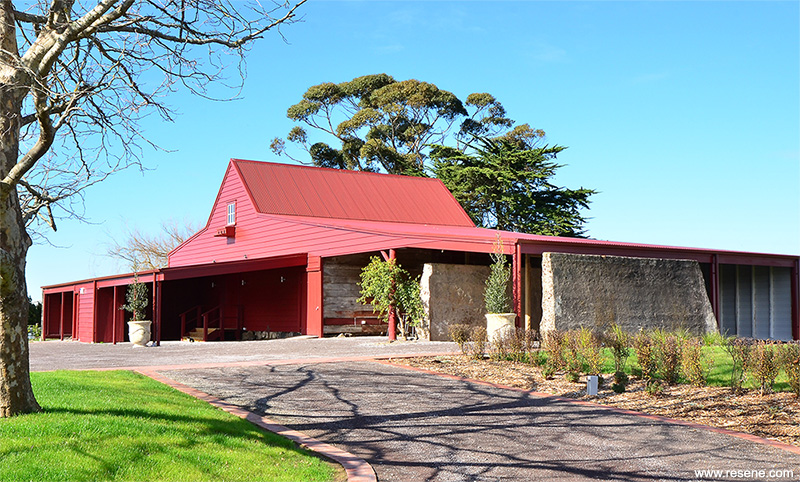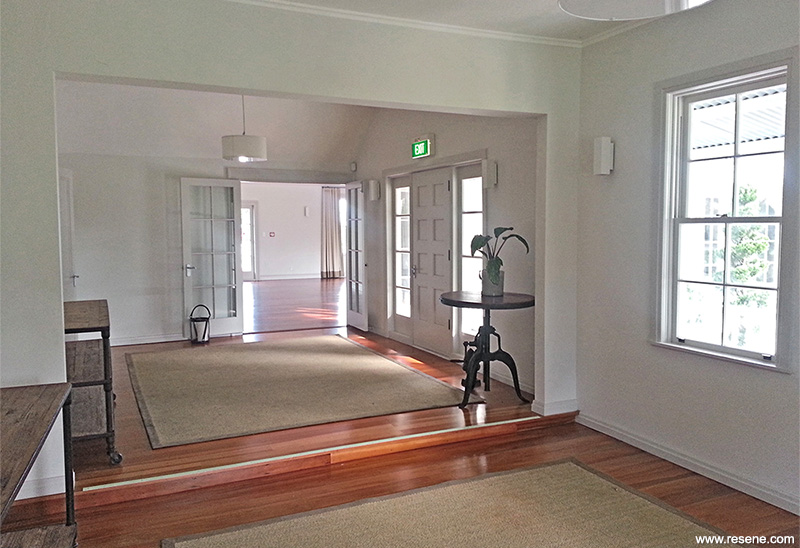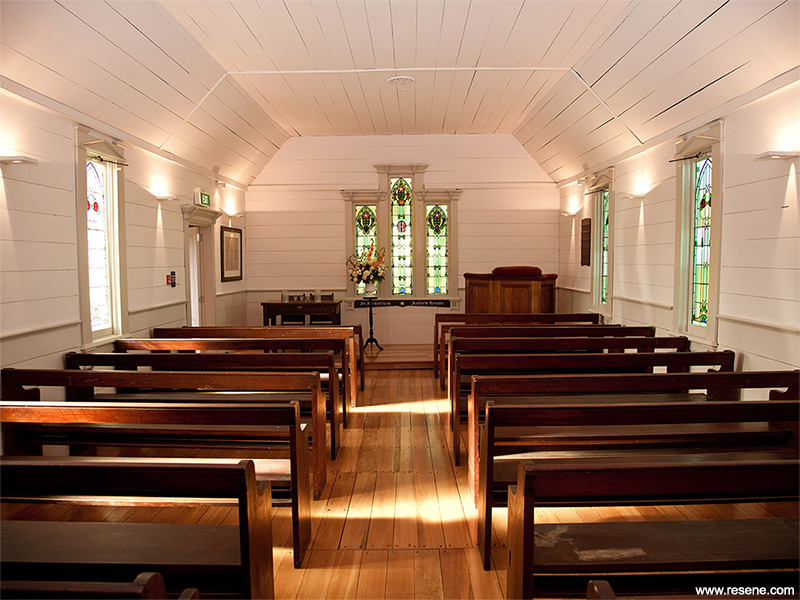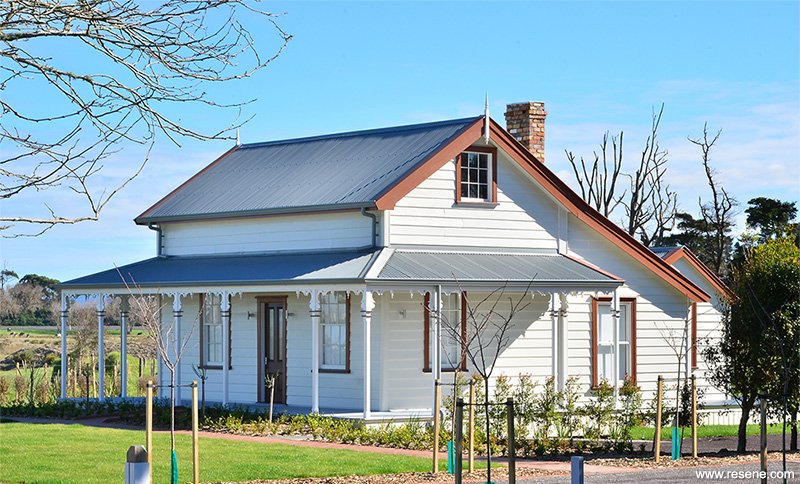Mangere
The old Nixon Homestead and associated barn are historic buildings located close to Auckland International Airport.

The earliest section of the homestead dates from 1852 and the barn was built around the same time to provide stabling.
Auckland International Airport Ltd desired to provide a unique en vironment near the airport for conferences and other events. The old homestead and barn were considered to be the ideal focus for an area to be known as the ‘Common’ that would be set aside for recreation and heritage activities. To form a heritage complex, two additional historic buildings were moved on to the site. These were the former Wesley Homestead, built a short distance away in 1855, and the Mangere Methodist Church, constructed in 1856.

The buildings had all been neglected with the church and the Westney Homestead, in particular, being in poor condition. They therefore had to be restored but also modified and adapted for new uses to make them commercially viable as a way of ensuring their preservation for future generations. The buildings also had to be adapted in such a way that their heritage values were preserved. The first stage was the preparation of conservation plans for the buildings to guide the proposed work. The New Zealand Historic Place Trust was also consulted at each stage.
The interior of the Nixon Homestead has been opened up and is now used for receptions while the barn can be used for informal dinners and other functions. The church retains its original use and is available for weddings and other events. The Westney Homestead is used for short term accommodation. The Nixon Homestead, in particular, needed new facilities such as a commercial kitchen and public toilets. Air conditioning and other services also had to be installed.

The precinct was extensively landscaped to visually connect the historic buildings. A series of courtyards was provided between the buildings with bricks being used for edging, along with red scoria as a reminder of the area’s volcanic past. A number of mature trees were retained including the macrocarpas along the driveway and new native and exotic species were planted.
The precinct now comprises a distinctive collection of buildings that have been restored and sensitively adapted for new and sustainable uses. The buildings together form a legacy that honours Mangere’s pioneers and celebrates the past, providing visitors with a unique experience and an insight into Auckland’s rural beginnings.
Inspiration for the barn colour was drawn from the historic farm buildings of New Zealand settlers. Red was commonly used on farm buildings throughout the country creating a striking effect against the landscape. Resene Red Ochre was used on the walls, doors and facings matching the red COLORSTEEL® roof and complementing the Resene Zinc White on the sash. The windows were defined by using Resene Half Spanish White.
Because the homestead has been altered dramatically over time and adapted for contemporary use, a neutral palette was chosen. Resene Eighth Tea was used for the walls with a darker colour, Resene Stonehenge, for the doors and handrails to the balustrade to distinguish these elements. The facings and verandah post capitals were accented with Resene Tea chosen to blend between the two former colours while defining these items. Resene Quarter Black White was used to highlight bargeboards, verandah posts, window sashes and balustrades. Timber decking was finished in Resene Non-Skid Deck & Path in Resene Relic to complete the look and provide a non-slip finish.
A similar colour palette is used on the interior with the front lounge in Resene Half Rice Cake, Resene Eighth Tea and Resene Legend moving through into the reception room of Resene Half Truffle, Resene Merino and Resene Quarter Rice Cake. The bathroom area is also kept to neutral tonings with Resene Perfect Taupe on walls, Resene Quarter Perfect Taupe on trims and Resene White Pointer on the ceiling.




The colours for the church were chosen after carefully scraping through various layers to identify original shades. Photographs, although black and white, also gave an indication on church colours. This resulted in the church being painted in Resene Half Dutch White which most closely resembled the building’s walls and the heritage colour Resene Ivy Green as an accent on the window facings and doors. Inside the colour palette moved to a neutral combination of Resene Half Tea on lower walls and Resene White Linen on upper walls and ceiling.

Again the walls and window facings were meticulously scraped to reveal early colours used on the homestead. Reference was also made to the time the home was constructed. Creams were among the colours used on early colonial buildings. Scrapings taken from the weatherboards revealed a colour similar to Resene Half Thorndon Cream chosen to paint the walls with Resene Eighth Thorndon Cream used on fretwork, verandah posts, windows sashes and finials.

An early scraping taken from the sills and doors revealed a colour similar to the Resene Heritage colour Resene Deep Chocolate. A lighter shade similar to Resene Fudge was discovered at the facings. We used the Resene Heritage range to choose these darker colours to create the most accurate colour palette for the era of the house.
The north facing deck was finished in Resene Skywater stain while the front verandah was finished in a blending grey of Resene Silver Chalice.
Architectural specifier:
Dave Pearson Architects Ltd
Building contractor: N Cole Ltd
Client:
Auckland International Airport Ltd
Painting contractor:
Contract Coatings; Target Painters
Photographer:
Dave Pearson Architects Ltd
Project: Resene Total Colour Awards 2013
Resene case studies/awards project gallery
View case studies that have used Resene products including many from our Resene Total Colour Awards. We hope these projects provide inspiration for decorating projects of your own... view projects
Total Colour Award winners:
2023 |
2022 |
2021 |
2020 |
2019 |
2018 |
2017 |
2016 |
2015 |
2014 |
2013 |
2012 |
2011 |
2010 |
Entry info
Latest projects | Project archive | Resene news archive | Colour chart archive